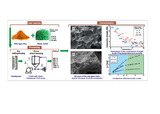JavaScript is disabled for your browser. Some features of this site may not work without it.
| dc.contributor.author | Shishkin, Andrei | |
| dc.contributor.author | Aguedal, Hakim | |
| dc.contributor.author | Goel, Gaurav | |
| dc.contributor.author | Peculevica, Julite | |
| dc.contributor.author | Newport, Darryl | |
| dc.contributor.author | Ozolins, Jurijs | |
| dc.date.accessioned | 2020-10-09T15:12:28Z | |
| dc.date.available | 2020-10-09T15:12:28Z | |
| dc.date.issued | 2020-10-07 | |
| dc.identifier.citation | Shishkin A, Aguedal H, Goel G, et al., (2021) nfluence of waste glass in the foaming process of open cell porous ceramic as filtration media for industrial wastewater. Journal of Cleaner Production, Volume 282, February 2021, Article number 124546 | en_UK |
| dc.identifier.issn | 0959-6526 | |
| dc.identifier.uri | https://doi.org/10.1016/j.jclepro.2020.124546 | |
| dc.identifier.uri | http://dspace.lib.cranfield.ac.uk/handle/1826/15872 | |
| dc.description.abstract | This paper reports the development and testing results of a prototype ceramic filter with excellent sorption properties (<99% elimination in 5 min) leading to good efficacy in the removal of industrial contaminants (Reactive Bezaktiv Turquoise Blue V-G (BTB) dye). The novelty in the investigation lies in developing the filter material obtained from the recycling of waste glass combined with highly porous open-cell clay material. This newly developed material showed a significant reduction in the energy requirements (sintering temperature required for the production of industrial filters) thus addressing the grand challenge of sustainable and cleaner manufacturing. The methodology entails sintering of the clay foam (CF) at temperatures ranging from 800 to 1050 °C and blending it with 5%, 7% and 10 wt.% milled glass cullet. One of the aims of this investigation was to evaluate and analyse the effect of the pH of the solution, contact time and equilibrium isotherm on the sorption process and the mechanical compressive strength, porosity, water uptake. From the kinetic studies, it was discovered that the experimental results were well aligned with the pseudo-second-order model and chemisorption was discovered to be a mechanism driving the adsorption process. These findings are crucial in designing cost-effective industrial filtration system since the filter material being proposed in this work is reusable, recyclable and readily available in abundance. Overall, the pathway for the reuse of waste glass shown by this work help address the sustainability targets set by the UN Charter via SDG 6 and SDG 12 | en_UK |
| dc.language.iso | en | en_UK |
| dc.publisher | Elsevier | en_UK |
| dc.rights | Attribution-NonCommercial-NoDerivatives 4.0 International | * |
| dc.rights.uri | http://creativecommons.org/licenses/by-nc-nd/4.0/ | * |
| dc.subject | isotherm | en_UK |
| dc.subject | textile dye | en_UK |
| dc.subject | sorption capacity | en_UK |
| dc.subject | open cell | en_UK |
| dc.subject | Ceramic clay foam | en_UK |
| dc.title | Influence of waste glass in the foaming process of open cell porous ceramic as filtration media for industrial wastewater | en_UK |
| dc.type | Article | en_UK |
Files in this item
The following license files are associated with this item:
This item appears in the following Collection(s)
-
Staff publications (SWEE) [2805]

